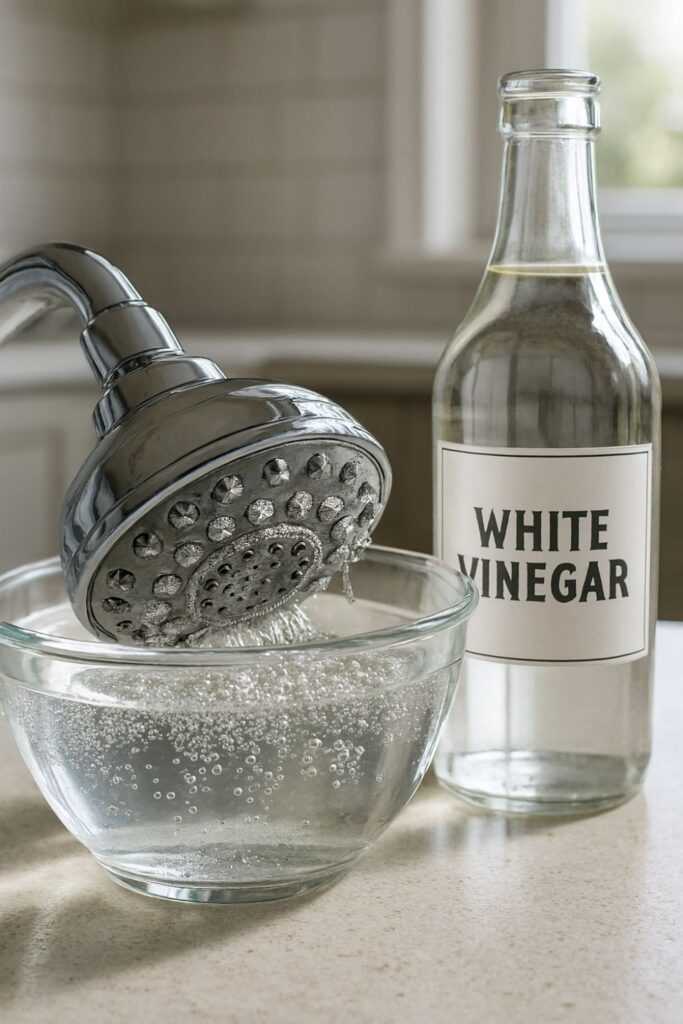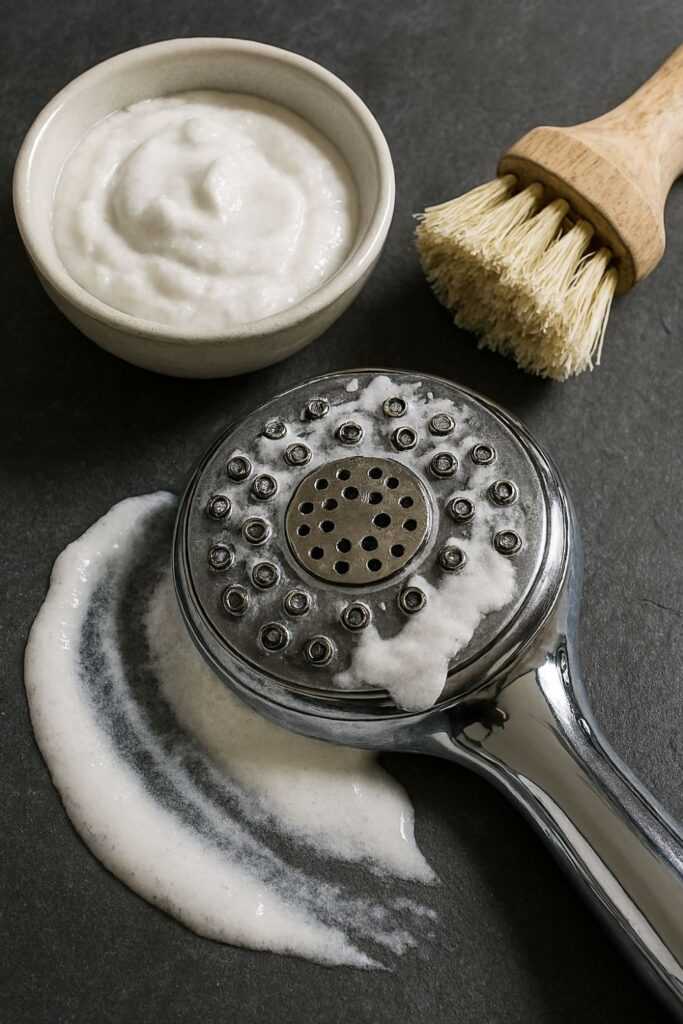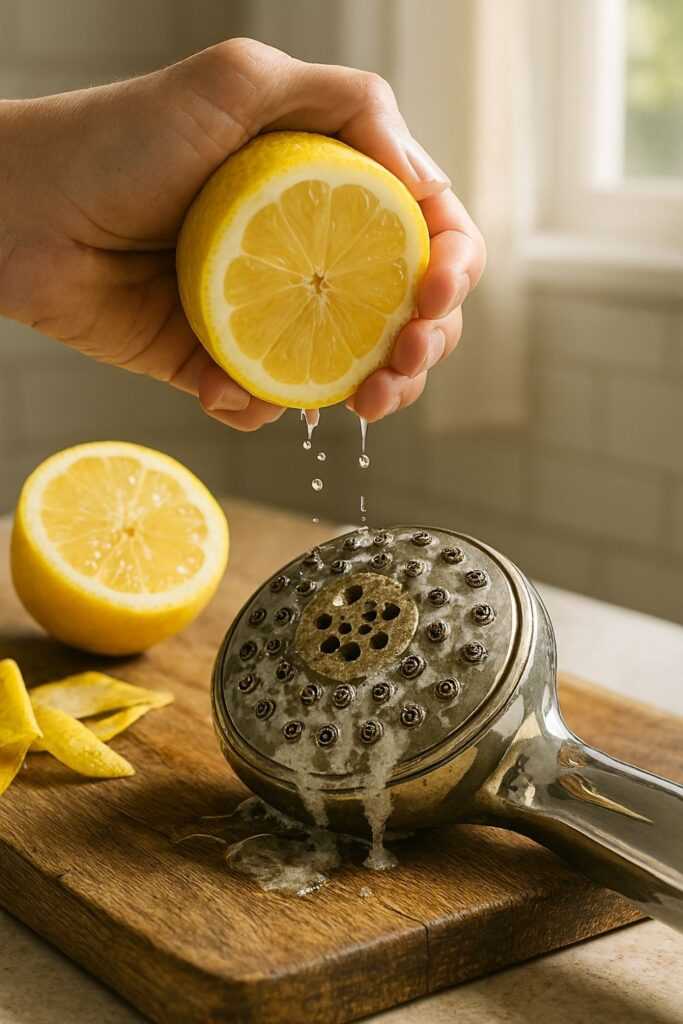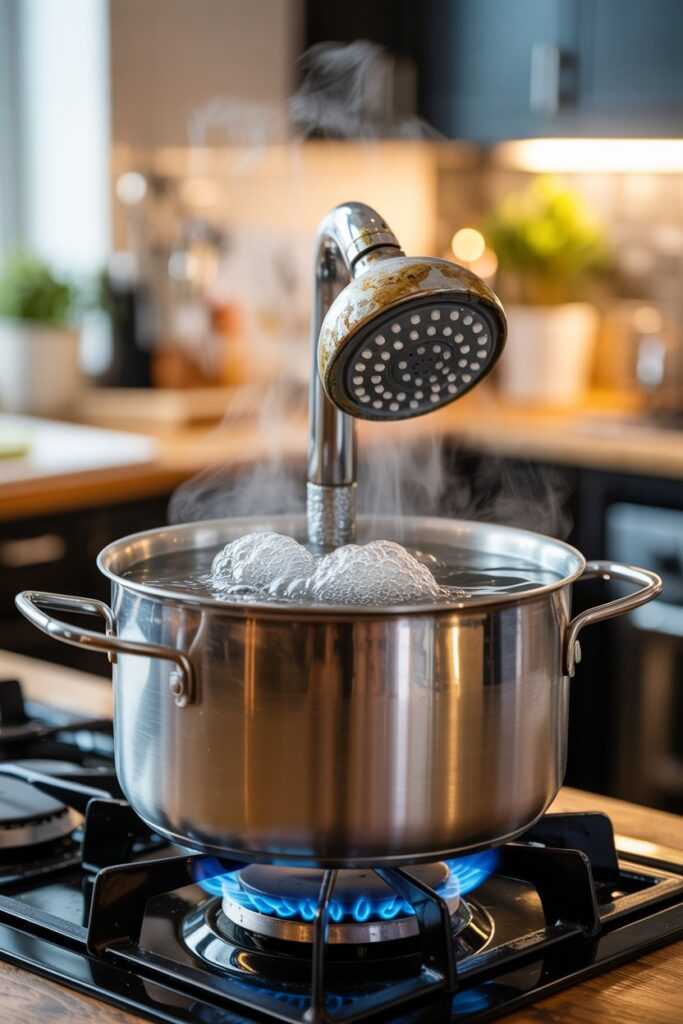Remove limescale from showerheads using common household items. This mineral buildup can block the tiny holes, lowering water pressure and leaving white stains.
The good news? You don’t need pricey cleaners or professionals for this. Simple ingredients from your home can break down stubborn limescale and restore your showerhead’s flow.
In this guide, we’ll share easy methods to clean and maintain your showerhead without harsh chemicals.
Say goodbye to buildup and hello to a cleaner, more powerful shower—all with items from your kitchen or bathroom cabinet.
Use White Vinegar

White vinegar is excellent for cleaning limescale off showerheads. Just fill a plastic bag with vinegar, tie it around the showerhead, and let it sit for a few hours. This method effectively dissolves lime deposits.
To ensure your showerhead is clean, scrub it gently with an old toothbrush after soaking. This removes any leftover limescale and clears the nozzles for better water flow.
You can also use this method for other bathroom fixtures like faucets. White vinegar is a natural and cost-effective solution that keeps your bathroom clean without harsh chemicals.
Check out these handy cleaning essentials available now on Amazon
Try Baking Soda

Mixing baking soda with water creates a paste that cleans your showerhead. This method breaks down limescale buildup, helping your showerhead look and work like new.
To use the paste, apply it to the limescale spots on the showerhead. Gently scrub with a soft brush or cloth to avoid damage. This method is both effective and gentle.
After scrubbing, rinse the showerhead thoroughly with water. This removes all residue, leaving it clean and free of limescale. It’s a simple and cost-effective way to maintain your bathroom fixtures.
Use Lemon Juice

Lemon juice is a great natural cleaner for limescale on showerheads. Soak a cloth in lemon juice, wrap it around the showerhead, and leave it for an hour. This method effectively dissolves the buildup.
Lemon juice also has antibacterial properties. It not only removes limescale but also sanitizes the showerhead. This ensures a cleaner and healthier bathroom.
Using lemon juice is eco-friendly for limescale removal. It avoids harsh chemicals that can harm the environment and your health. This makes it a safe choice for regular use at home.
Shop the best household items for limescale removal on Amazon
Use a Toothbrush

An old toothbrush is perfect for cleaning your showerhead. Use it with your favorite cleaner and gently scrub away limescale. This method lets you access tight spaces easily.
A toothbrush is great for stubborn limescale deposits. Its bristles reach spots that other tools can’t. Regular scrubbing keeps your showerhead looking new and working well.
If your showerhead is detachable, remove it. Use the toothbrush to clean the nozzles and other parts thoroughly. This tool helps maintain good water flow and prevents blockages from limescale.
Boil the Showerhead

If your showerhead is removable, you can boil it in water with vinegar to remove limescale. This method is easy and works well, restoring your showerhead to like-new condition.
To start, fill a pot with water and add some vinegar. Bring the mixture to a boil, then place the showerhead in the pot. Let it simmer for a few minutes to help the vinegar dissolve the buildup.
After boiling, carefully take out the showerhead and rinse it well. This process removes limescale and clears other debris, improving water flow and giving you a cleaner shower experience.
Discover affordable showerhead cleaning tools ready to order on Amazon
Conclusion
Removing limescale from your showerhead is easy with household items. You can use vinegar, baking soda, lemon juice, and a few other common products.
These will help keep your showerhead clean and working well. Regular cleaning will keep your shower fresh and efficient. Try these methods for a better shower experience.
How Often Should You Clean A Showerhead To Prevent Limescale?
Clean your showerhead every one to three months. The frequency depends on your water hardness.
In hard water areas, limescale builds up quickly and can block water flow. Regular cleaning stops this and keeps water pressure steady.
Frequent maintenance also extends the showerhead’s lifespan. Instead of replacing it from mineral buildup, cleaning keeps it in good shape for years.
Can Limescale Damage A Showerhead Over Time?
Yes, limescale can harm a showerhead if not addressed. The mineral buildup blocks nozzles, cutting water flow and straining the fixture. Over time, this causes uneven spray patterns or even permanent clogs.
Regular limescale removal prevents corrosion and keeps your showerhead efficient. This helps you avoid buying a replacement too soon.
Is Vinegar Safe For All Types Of Showerheads?
White vinegar is safe for most showerheads, particularly metal ones. Some finishes, like gold-plated or special coatings, can be sensitive to acidic cleaners. Always test a small area first to prevent damage.
If your showerhead has a delicate finish, dilute the vinegar with water. This keeps the cleaning power while lowering the risk of corrosion.
What’s The Fastest Way To Remove Limescale From A Showerhead?
Soak the showerhead in vinegar for a few hours. This method breaks down tough mineral deposits without harsh scrubbing.
After soaking, use a toothbrush to scrub away any leftover buildup.
If the showerhead is detachable, boil it in water mixed with vinegar. This speeds up the process even more and restores strong water flow in minutes.
Are There Eco-Friendly Alternatives To Store-Bought Cleaners?
Yes, items like vinegar, baking soda, and lemon juice are great eco-friendly cleaners. They remove limescale effectively without harsh chemicals that can harm the environment.
Using these natural solutions saves money and lowers exposure to toxic ingredients. They’re safe for regular use and gentle on most bathroom fixtures.
